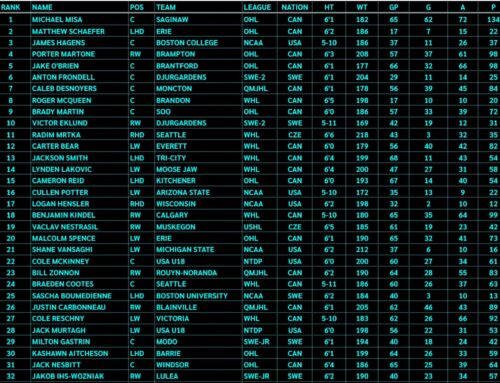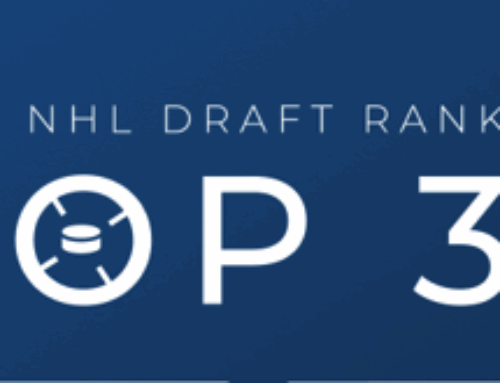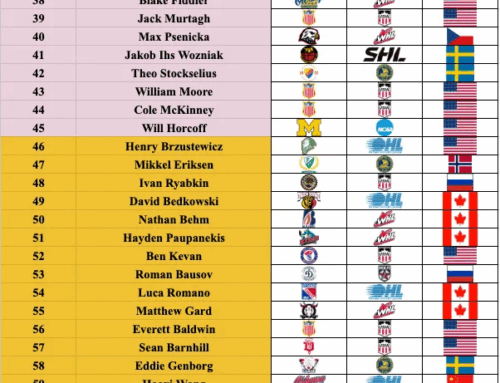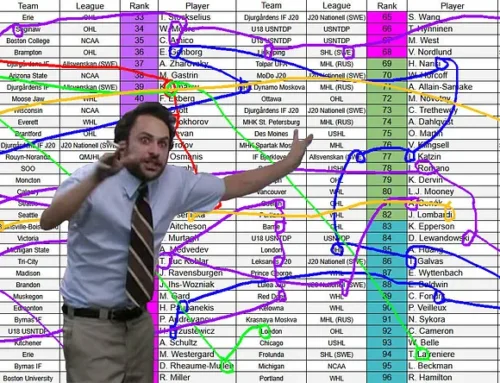Late-Round Gems from Central Europe
Jeff Rea
2020-10-06
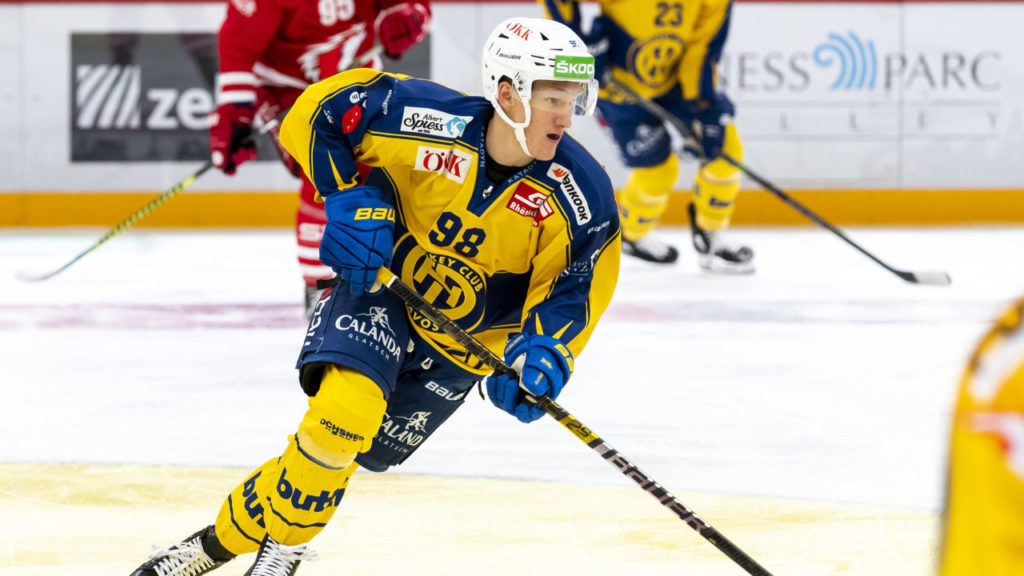
28.09.2019; Lausanne; Eishockey National League- Lausanne HC – HC Davos; Benjamin Baumgartner (Davos) (Pascal Muller/freshfocus)
Central Europe is far from an NHL amateur scouting hotbed. But it’s not that the region isn’t producing talent. From 2008-17, a Swiss player was selected in the first round in seven of ten NHL Entry Drafts. Bern products Roman Josi and Nico Hischier have made lasting impressions on the league and Kevin Fiala, Nino Niederreiter, and Timo Meier have established themselves as impactful players for their teams.
This will be the third consecutive year a German is selected in round one of the NHL Draft. By the end of the first evening, three German names may be called. It was also the year a German won the Art Ross Trophy and the year a German was given a chance to backstop the Avs in their quest for Stanley. Even Austria has left a modest mark on the league. Notably, of their 12 drafted players, Thomas Vanek went 5th and Michael Grabner went 14th. Marco Rossi, of course, is next in line.
So why is this region so under-scouted?
The majority of the aforementioned players were gone come their draft year. They had transferred to junior clubs in Sweden, were selected in CHL Import Drafts, were studying at US colleges or playing pro hockey in Europe, already. These are the places you find the majority of Central European draft-eligible headliners.
This season is odd. One highly-rated German lived up to the hype in the DEL and two others rose to that level and stood out, as well. We all know Stützle, Peterka, and Reichel. This article is not about them, it’s about the next wave of Central European based players. Introducing Florian Elias, Benjamin Baumgartner, and Maximilian Glötzl, and presenting reasons to call their name (or pass them over) in the late rounds of the 2020 Draft.
Reasons to call the name Florian Elias.
Florian Elias is a highly-intelligent player. His natural ability to process the game and anticipate need makes him impactful in all three zones. Offensively, Elias is a hound. He circles around the offensive zone, using his strong edges and low center of gravity to dart in and out of holes. He is relentless on the puck, and eager to make hits and create turnovers. He sees the ice exceptionally well and displays creativity. His timing is an asset. Elias reads build-up and gets himself into high danger areas, where he is often ready to pounce on loose pucks and bury goals.
Elias gets around the ice well. He is constantly shifting, pivoting, and changing his angles. He is elusive and unpredictable. He’s small, which allows him to dart into small gaps and find space. He’s strong on the puck, spins off defenders well, changes direction with ease, and is well-balanced. His escapability is impressive and he skates as well backward, as forwards.
Florian Elias is a playmaker. He uses mohawk turns to open himself up to the ice, surveys effectively, and completes a high percentage of his passes. He creates chances for his wingers on the rush and uses his defenseman well in the offensive zone. On the powerplay, he plays along the left half-wall, often looping up high to receive passes and dive back down into play. He essentially played the same role Tim Stützle played for the U20s at the WJC.
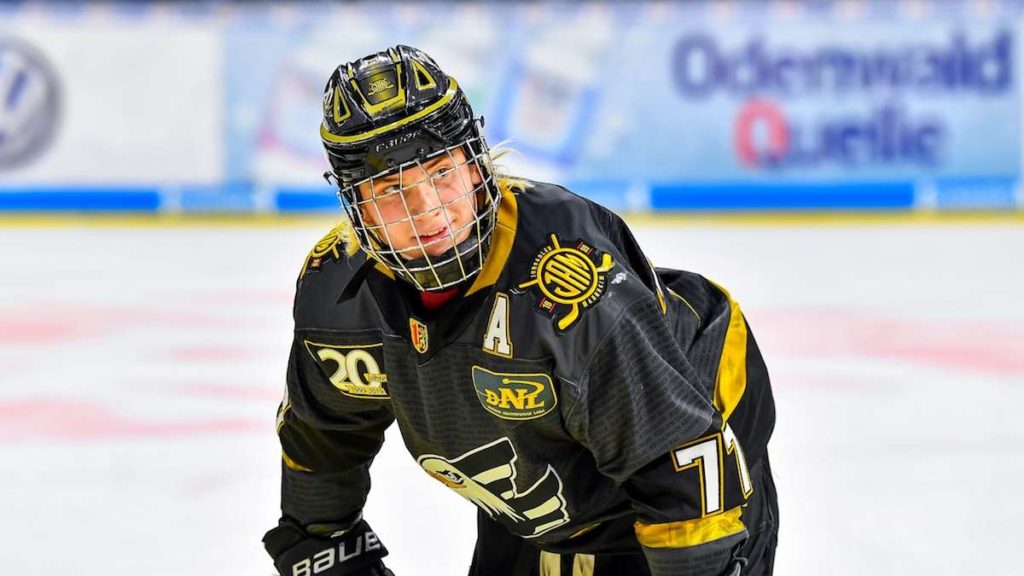
Florian Elias photo courtesy of https://www.mannheim24.de/
Unlike most pass-first players, Florian Elias also led the league in goal-scoring this year (26 goals in 30 games). He is fluid and eye-catching in transition, easily gains zones, and often takes the puck from one end to the other. Elias enjoys coming back low to collect pucks in the defensive zone. Likewise, he curls low on breakouts and is often a passing option on regroups. He wants the puck. He weaves through defenders on the exit and accelerates through the neutral zone, pushing Dmen back. He has the ability to drive a game and dictate the pace of play. Often, he’ll start periods with an impactful shift and or a goal.
Elias enjoys having the puck on his stick. He draws players to him and creates space for his linemates. He has soft, quick, and decisive hands. His shot is above average. He places pucks in the net and scores goals using his quick release and a strong sense of positioning.
Defensively, Elias is useful as well. He’s strong on the forecheck and often wins board battles. He reads the direction of play well and gets his stick into passing lanes. He is a takeaway machine, stripping players of pucks using his exceptional stick control, edgework, soft hands, and dogged determination. Once he wins the puck, he’s off in transition and on the offensive immediately.
He wore an A for German U18s and led them in scoring. He’s young for his draft class and plays in Germany’s premier organization. He scores big goals in big games and is a winner. He plays in all special teams situations and takes the big faceoffs.
There is a lot to like.
Reasons to pass on Florian Elias.
As good as he’s been, Elias’ doubters will rightfully question his level of competition. Elias was dominant in the German DNL (U20), but few draft-eligible recruits find themself in that league to begin with. His D-1 season was close to Lukas Reichel’s (1.31 versus 1.22 ppg) but nowhere close to Tim Stützle’s (2.62). Both Stützle and Reichel moved on to have impressive draft years. Elias stayed behind and showed modest improvement.
Elias was robbed of his chance to showcase his game at the World U18s. His performance in December’s 5 Nations was overshadowed by the World Juniors, which took place at the same time. The U18 competition was not as strong as it should have been and his accomplishments there are often overlooked.
Elias is also small. And a Center. Teams may be doubly concerned, wondering how his game will translate and if he’s capable of playing as a pivot at a professional level, against men, at 5’8, 170lbs. There are also some weaknesses to his game. Elias needs to improve his awareness in the defensive zone. At times he is too focused on the puck and impending transition. He has a tendency to be pulled away from the areas he should be covering. Likewise, on the backcheck, Elias is a little too one-tracked. He often chases the wrong man and fails to notice the trailer.
Although Elias is a strong skater, his explosiveness and agility could be improved. He’s a heavy skater and has a strong base, but his turnover is a little slow and his ability to shift gears quickly is lacking. He also lacks top gear and when his legs aren’t moving he looks slow and lethargic. Elias has scored a lot of goals in the DNL. But without a strong outside shot and with a tendency to score in high traffic areas, one has to question his ability to continue producing goals at the next level.
Elias would most certainly benefit from having a strong slap shot. He takes the offensive zone well and backs Dmen off him, which would allow him to let off a Paul-Kariya-like shot off the rush upon entry. Currently, that’s not a skill he has in his toolbox. His shots from the outside are weak and sometimes off-target altogether.
Perhaps that’s why Florian Elias so often over-passes. He has a tendency to force plays on odd-man rushes and attempts seam passes which aren’t there. Often these attempts came when he was in a good scoring position, too. He needs to work on his shot and shoot more often.
Consensus on Elias
Florian Elias is too hard to completely pass on.
Yes, he’s unproven against better competition, but he has also risen to not only lead but dominate whenever given a chance. His U18 statistics for Germany are telling. His 21 points in 20 games are fourth all-time; Rieder (27), Stützle (25), Draisaitl (22), and Kühnhackl (20) are the others in his range. He led the Germans to a 5 Nations Tournament title in Zuchwil, this past December, he’s a former DNL champion, and he’s already been signed to a professional deal by Mannheim. He’s done things.
Yes, he’s small. And yes, he’s a small center. But he also plays the game with a rare level of maturity, poise, and confidence. In ways, he seems desperate for the next challenge, not scared of it. Virtually every scout with multiple viewings raves about Florian Elias. Surely an NHL scout has seen the glimmer, as well.
Projection: 5th or 6th Round
Reasons to call the name Benjamin Baumgartner
Whereas Florian Elias is your prototypical boom or bust late rounder, Benjamin Baumgartner couldn’t be more safe and dependable. The 20-year-old Austrian has established himself as a reliable two-way center in the Swiss NLA, already.
Baumgartner’s 27 points in 37 games were in a league of his own. Thirty-two players under 20 played in the NLA last season. Baumgartner was the only one to record more than 11 points. His 0.73 ppg are the fifth most for an NLA D+2 player since 2000-01. Halfway through the season, Baumgartner represented Austria at the WJC 1A. The Austrians, without Marco Rossi no less, managed to win promotion. Baumgartner led the tournament in scoring with 5 goals and 11 points in 5 games and was highly praised for his role in Austria’s success. His 11 points were only two off Tobias Rieder’s all-time tournament record, 13.
But here’s where it gets wild. Benjamin Baumgartner is not an offensive player. His versatility and well-rounded package allow him to excel in various circumstances. He prides himself on being a high forward and does little things so well people come to expect them of him. He wins draws, picks up trailers and he gets the puck out of his zone. He positions himself well and is a trustworthy passing option.
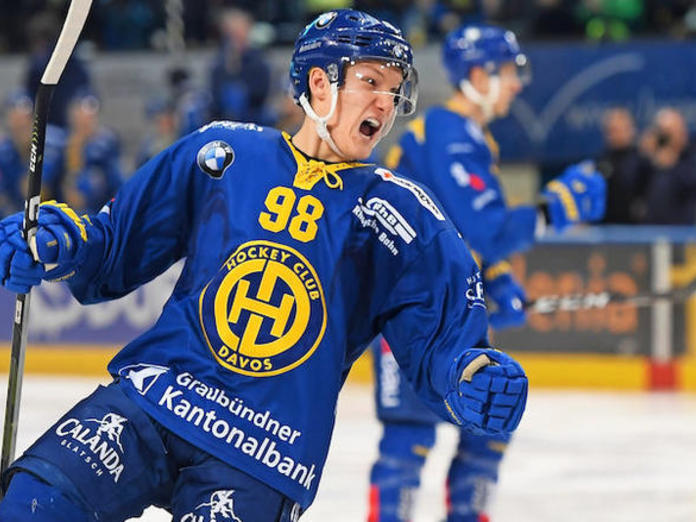
Photo courtesy of https://www.sihf.ch/de/national-league/
More than anything, Benjamin Baumgartner is a responsible defensive asset. He sees the ice well and gets around well enough to be in a good position to support his teammates. He makes short and safe plays with the puck, seemingly assessing risk instantaneously. His stick usage is impressive. He closes lanes and strips pucks effectively from opponents. He wins most of his defensive zone board battles by outsmarting opponents, craftily choosing his angles, using his body, and stealing the puck. He is extremely useful in support of his defensemen behind the net. In the offensive zone, his tendency is to play high, which allows others (this year it was often Aaron Palushaj or Mattias Tedenby) to play more openly and freely. Not surprisingly, Palushaj and Tedenby comfortably led HCD in goals.
Baumgartner is strong in transition. In the neutral zone, he plays simple hockey. He makes clean exits and is primarily a north-south player through the middle of the ice. He receives pucks in stride well and is able to handle the puck well at speed. Baumgartner is highly versatile. He can play all three forward positions and is used both on the penalty kill and on the powerplay. He can play the safe game, generate chances for his wingers, or potentially drive play, as he did at the WJC 1A for Austria.
Benjamin Baumgartner gets around the ice well. He’s light on his skates and moves seamlessly and effectively. He is well-balanced, athletic and he has a good engine. He stops and starts effortlessly and his top gear is decent enough. He takes good routes and understands angles. He chases play down on the backcheck and plays a high energy game. His blueline to blueline speed is good and he skates as well with the puck as he does without it. He uses his inside edges well, mobilizes his ankle effectively, and uses crossovers and half steps economically. The Swiss are widely recognized as strong skaters, and Baumgartner is more than able to hold his own in their top professional league as a U20.
He is fairly smart on the cycle and he is willing to drag pucks to the net or get dirty in the slot. He likes to curl and look for trailers or open teammates behind the rush. He delays and draws players to him, then using his high IQ and soft hands to dish the puck. He’s a deceptive and calculated player with many areas of strength.
Reasons to pass on Benjamin Baumgartner
Baumgartner stands a modest 5’9, 165. He’s also a double-overager. There. I said it. In terms of his game, Baumgartner lacks creativity. On entries, he lacks confidence. He often crosses the line, pulls up, and throws the puck down low. He’s more comfortable on the cycle than on the rush.
Benjamin Baumgartner is a complementary player who would rather make a safe play than a risky and more lucrative one. Although there are shifts where he’s buzzing around the offensive zone creating chances, his scoring upside is hindered by a lack of size, strength, and shot power. He seems to lack hunger for goals at times, as his priority is to be responsible. His shots off the rush are sometimes blocked, poorly-timed or nonthreatening. He can take too long on chances and seems to overthink things on the offensive end, especially when afforded a lot of time.
Baumgartner’s more obvious shortcoming is physicality. He’s light and seemingly weak. He’s often pushed off the puck with ease, hacked after whistles, and on the losing end of offensive zone board battles. He bounces off players on the forecheck. He struggles to push off of defensemen in front of the net. Baumgartner needs to add muscle and at 20 already he may be a tad behind in terms of development and strength.
Consensus on Benjamin Baumgartner
Benjamin Baumgartner is the type of player who can help your team win hockey games. He can play as a shutdown center or be used on a scoring line to free up others. He can kill penalties or be used as a puck distributor on the powerplay. He can play any forward position, on any line. He thinks the game at an elite level and takes his defensive responsibilities most seriously.
He has earned the respect of his teammates in Davos and the love of the fans in a hockey-mad community. It’s quite possible his game will translate well to the NHL. Sure, there may be less upside, but there is also less risk. He’s already a professional hockey player. He needs to add substantial muscle and work on his shot. But these are easy fixes. He could quite easily be drafted and left to simmer for a few years in Europe. At 23, for example, he may be an extremely useful piece on a winning team.
Projection: 5th or 6th Round
Reasons to call the name Maximilian Glötzl
Spoiler Alert! I’m not high on Maximilian Glötzl. Having said that, he’s likely to be drafted for the following reasons. Maximilian Glötzl has the package. He moves well, wears an A for Germany, and stands 6’2, 198lbs. He has a reputation that precedes him and he’s confident. He plays on winning teams and benefits statistically because of it.
He also likes to join the rush. Now we have a D-man with a combination of size, perceived leadership, offensive production, and skating. Enticing, no? Glötzl moves relatively well in all four directions. His backward skating is smooth and he is strong on his skates. He likes to charge forward and is particularly effective at four on four. He likes to drive the net on the rush, too, which opens up space for his forwards. Glötzl was also given a cup of tea in the DEL this season. He impressed some with his play in those two viewings.
The cosmetics look good.
Reasons to pass on Maximilian Glötzl
Glötzl’s game has a number of concerning features, many of which I’m uncertain can be addressed. For starters, he processes the game poorly. He struggles to make appropriate reads, turns the puck over unnecessarily, is reactive, and chases play in his own zone and he does not hold the line well or control gaps in an effective manner. That’s a pretty damning list for a draft-eligible defenseman in the DNL.
His gap control is poor. So poor, in fact, he often finds himself at the top of the circles when the forward on the rush is entering the zone. At times, he stops and comes forward to make a hit; often these attempts fail, and sometimes they result in penalties. In the defensive zone, he is standoffish and slow to engage. He doesn’t put pressure on the puck carrier and he concedes far too much space. When angry, he’s a menace. He can staple players to the boards and play with intimidation and grit. But that infrequently happens. For the most part, he’s a passenger.
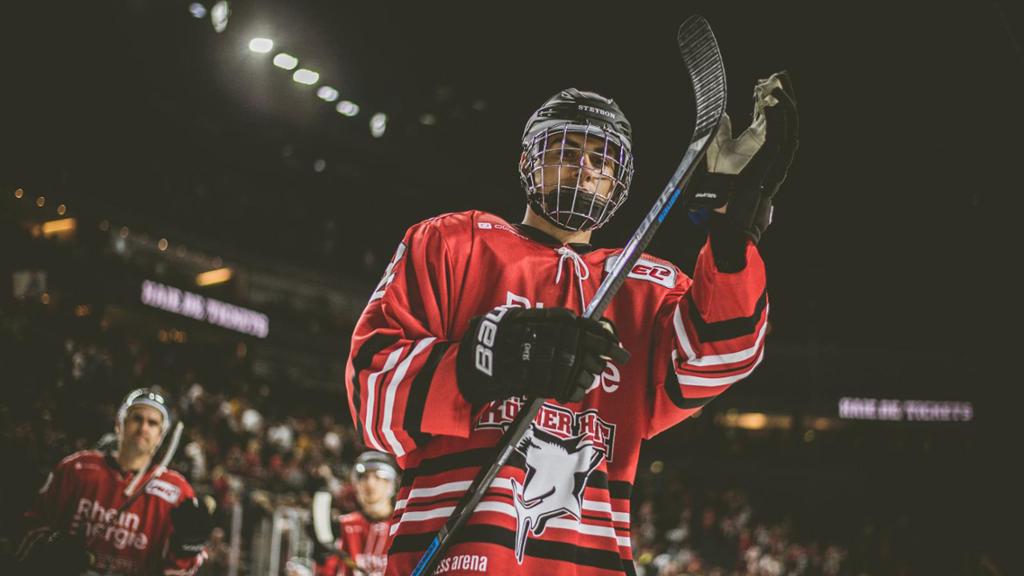
Maximilian Glötzl photo courtesy of NHL.com
With the puck, Glötzl is frivolous. He’s uncomfortable carrying the puck on the breakout, forces play in the offensive zone, and often just turns it over (even when tactical passing options are available to him) when pressure is exerted. He often panics when carrying the puck and seems uncomfortable making outlet passes. On the regroup or breakout, he often passes the puck laterally between his D partner and or waits for a forward to come back to retrieve it. He also throws the puck off the boards and out far too easily, in the defensive zone. Rarely does he make stretch passes or drive offense off the rush. When he does get going with the puck (his acceleration is poor), he often runs out of space, dishes it to a nearby teammate, dumps it in, or turns it over.
He also struggles to get shots through. Rarely does he take an opportunity to unleash a hard one-timer. Even on the powerplay, he’s often looking to move the puck around or throw a wrister at the net. Allegedly he has a big shot. I did not see it in the ten plus games I tracked.
At times in the offensive zone, he puts his partner into trouble. He makes ill-advised passes in the face of danger and often forces D-to-D puck movement when there is high pressure. He does not walk the line well and often receives the puck flat-footed. It’s odd he gets so much powerplay time, as he lacks creativity moving the puck, doesn’t carry the puck well, and is rarely a dangerous shot option. At times he even backs off the line in the offensive zone for no reason at all. He drifts back as far as the red line and watches play from there. It does not bode well.
Consensus on Maximilian Glötzl
In December there were questions over his omission from the WJC team. Instead, he went and played for the U18s at a 5 Nations Tournament (devoid of its stars). There he was serviceable, at best. A top-four Dman on a winning team, and nothing more. Clearly, based on the detailed analysis of the player, there are some concerning elements that cannot be overlooked.
Projection: I reckon someone may stop and kick his tires. Buyer beware.
*****
Follow Jeff on Twitter at @JeffReaScouting



